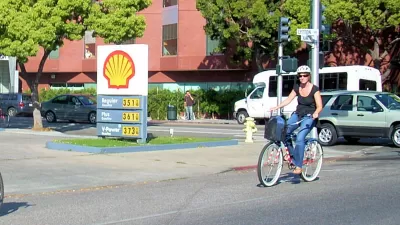Vermont's legislature will take up the carbon tax proposal this week. The tax is construed as largely revenue neutral, i.e., offset by tax decreases and credits, and apply to heating and transportation fuels. Gov. Peter Shumlin has doubts.
"A coalition of 200 businesses, including Ben & Jerry's and Seventh Generation, say it's time for Vermont to be the first state to move forward with a carbon tax," writes Alexei Rubenstein for WCAX News. "The House Natural Resources Committee this week began digging into the issue."
"Two bills introduced in the Vermont House this session would establish a tax on fossil fuels that emit greenhouse gases," writes Rubenstein. "One would impose a graduated $10 per ton of CO2 emissions tax on fuel distributors. It would increase every year until maxing out at $100 per ton."
In both bills, up to 90 percent of the money collected would be offset by reductions in other taxes or tax credits. A portion of the revenue would also fund weatherization projects for low-income earners.
According to an earlier Burlington Free Press article, the tax would not apply to electricity generation as utility companies already participate in the Regional Greenhouse Gas Initiative (RGGI).
"Gov. Peter Shumlin, D-Vermont, has said he supports a regional [as RGGI does for power plant emissions] or national approach, and that Vermont can't do it in isolation," writes Rubenstein. "So far, no state has gone out on its own to tax carbon pollution. Opponents say there's a good reason for that."
California opted to construct a cap-and-trade program that operates in a similar manner as a carbon tax. Motorists pay about 10-cents a gallon to emit carbon from burning gasoline and diesel, on top of carbon charges that oil refineries pay to produce the fuels.
But opponents to the Vermont tax have it right. One reason California chose to go with carbon trading was because a carbon tax was deemed too difficult to pass the legislature. Instead, legislators supported AB 32, which authorized the nation's first state-run (as opposed to regional) cap-and-trade program.
"We already feel the impact of a tax differential on the New Hampshire border," states Shumlin. "The difference in our gas tax [30.46 cents-per-gallon compared to New Hampshire's 23.83 cents] alone is 8 cents right now, and as a result of that, most of the business is down across the border."
Gov. Shumlin's calculation is slightly off because the state gas tax dropped 1.5-cents since January 1 according to the April 1 figures supplied by the American Petroleum Institute [PDF], which needs some explanation because he signed a six-cent increase in gas taxes almost two years ago.
Like so many gas tax increases approved prior to the plunge in gas prices last July, it was based on implementing new or increasing existing retail or wholesale fuel sales taxes while reducing per-gallon excise taxes [see "notes" in API (PDF)]. Who could have predicted decreasing gas taxes would result from increasing gas taxes due to the precipitous fall in gas prices?
Advocates point to efforts in Oregon and Washington to adopt carbon taxes (or carbon fees) as well.
Hat tip to AASHTO Daily Transportation Update.
FULL STORY: Vermont businesses line up behind carbon tax

Maui's Vacation Rental Debate Turns Ugly
Verbal attacks, misinformation campaigns and fistfights plague a high-stakes debate to convert thousands of vacation rentals into long-term housing.

Planetizen Federal Action Tracker
A weekly monitor of how Trump’s orders and actions are impacting planners and planning in America.

San Francisco Suspends Traffic Calming Amidst Record Deaths
Citing “a challenging fiscal landscape,” the city will cease the program on the heels of 42 traffic deaths, including 24 pedestrians.

Defunct Pittsburgh Power Plant to Become Residential Tower
A decommissioned steam heat plant will be redeveloped into almost 100 affordable housing units.

Trump Prompts Restructuring of Transportation Research Board in “Unprecedented Overreach”
The TRB has eliminated more than half of its committees including those focused on climate, equity, and cities.

Amtrak Rolls Out New Orleans to Alabama “Mardi Gras” Train
The new service will operate morning and evening departures between Mobile and New Orleans.
Urban Design for Planners 1: Software Tools
This six-course series explores essential urban design concepts using open source software and equips planners with the tools they need to participate fully in the urban design process.
Planning for Universal Design
Learn the tools for implementing Universal Design in planning regulations.
Heyer Gruel & Associates PA
JM Goldson LLC
Custer County Colorado
City of Camden Redevelopment Agency
City of Astoria
Transportation Research & Education Center (TREC) at Portland State University
Jefferson Parish Government
Camden Redevelopment Agency
City of Claremont





























